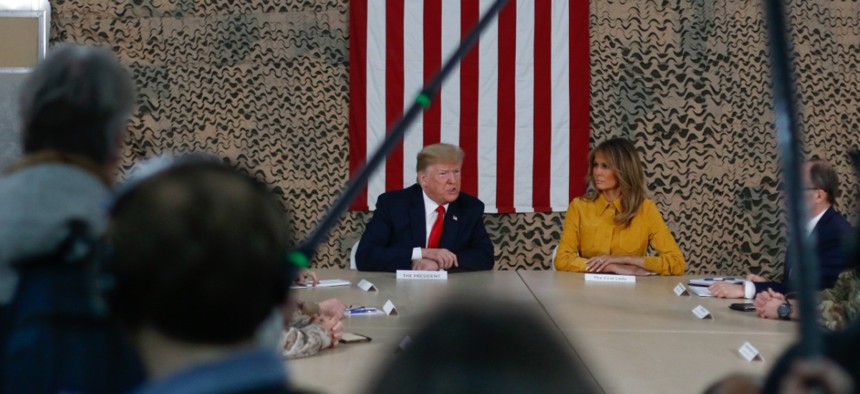
President Trump spoke to U.S. troops at al Asad Air Base in Iraq in 2018. 1st Lt. Leland White/U.S. Army National Guard
The One War Zone Trump Doesn’t Want to Leave
The president’s resistance to withdrawing from Iraq boils down to three of his main enemies: ISIS, Iran, and Obama.
Donald Trump has harangued generals at the Pentagon over what he’s called the “loser war” in Afghanistan and their failure to end it. He has dismissed Syria as “sand and death,” and complained that the United States was supposed to be there for only a “short-term hit.” He has sought and failed to get rapid pullouts from both places. But he hasn’t made any such promise for Iraq. In fact, he has recently made the opposite case: that the roughly 5,000 U.S. troops there must stay.
When the Iraqi Parliament voted to expel U.S. troops last month—out of anger for the brazen strike that killed an Iranian general in Iraq without its government’s approval—Trump vowed not to leave at all, and threatened sanctions if forced to do so.
Why is Iraq the one country where Trump seems to want to stick around, especially since he campaigned on having opposed the 2003 war there? Why, given Trump’s statements that he’s defeated ISIS, has he not used the supposed victory to get out of Iraq as well as Syria? To the extent that Trump cares about Iraq at all, the answer that emerges from conversations with current and former officials and advisers boils down to three of Trump’s main enemies: ISIS, Barack Obama, and Iran.
"I’m convinced that he hasn’t made any pronouncements about getting out of Iraq because he knows full well that ISIS can reemerge. They have a presence there,” Jack Keane, a retired general and informal adviser to the president on national-security matters, told me. “And he understands that if we unilaterally pulled out and this thing caught on fire again, he would own it in a way that Obama owned it after he withdrew.” Trump, he said, is sensitive to what happened when his predecessor left Iraq and ISIS rose from the remnants of the war many Americans had thought was over.
Trump himself made this clear on the campaign trail in 2016, despite also lamenting the U.S. going into Iraq at all. Obama withdrew troops from Iraq in 2011, unable to secure a new agreement with the Iraqi government to keep them there longer. Iraq was forced to invite the U.S. military back to fight ISIS, which in the summer of 2014 was threatening genocide against the Yazidis and beheading hostages, including Americans.
By 2016, Trump was convinced of two things: ISIS was Obama’s fault, and the U.S. had to stay in Iraq to fight it. Iraq was now the “Harvard for terrorism,” he said. That left no choice but to “take care of it.”
And so once Trump took office, he sped up the military campaign against ISIS and notched a major victory with the fall of the Islamic State’s Iraqi capital in 2017. In the spring of 2019, he declared the territorial defeat of ISIS, and later that year, ISIS’s leader, Abu Bakr al-Baghdadi, killed himself during a U.S. Special Operations raid.
But Trump, despite his private and public complaints about the expense, did not promise to withdraw from Iraq, the central staging ground for the U.S. counter-ISIS fight. Instead, he has focused on getting troops out of Syria, where a complex battlefield currently includes some 500 U.S. troops butting up against the competing interests of Turkey, a NATO ally; U.S. adversaries such as Russia, the Syrian government, and Iran; and ISIS remnants.
Furthermore, Keane said, “it’s the U.S. military leaders in Iraq that actually run the U.S. coalition war against ISIS in Syria, so we're managing Syria and Iraq from Iraq.” Put another way, the U.S. could still fight ISIS without Syria; it could not fight ISIS without Iraq.
So the first time he was ready to declare victory against ISIS, back in December 2018, when the group was still clinging to its last scraps of territory, Trump may have spotted a double political benefit: He could announce what looked like a big troop withdrawal and claim to end the war in one country, while also vowing to keep ISIS down. Thus, when he took a hastily organized trip to Iraq that month, he started talking about bringing troops home—from Syria. He toured the massive al-Asad Air Base, in western Iraq—a “fantastic edifice,” he later called it—and marveled at the size of its runways. Then he told the troops there that they would stay put “to prevent an ISIS resurgence and to protect U.S. interests.”
The base itself also spoke to Trump’s real-estate interests: He evidently thought the U.S. had built it, though it has stood in Iraq’s Anbar province since Yugoslavian contractors helped put it there in the 1980s. He told CBS: “We spent a fortune on building this incredible base. We might as well keep it.” And then he added a new reason to stay in Iraq. “One of the reasons I want to keep it is because I want to be looking a little bit at Iran, because Iran is a real problem.”
Indeed, this remark hinted at a new phase in Trump’s involvement in the Middle East. His priorities have shifted from the defeat of ISIS to the pressure campaign against Iran. When ISIS was at full strength, both U.S. and Iran-backed forces in Iraq considered the group their enemy, turning their guns against the insurgents rather than each other, as they had previously in the Iraq War. But with ISIS gone and Trump undertaking an ever-intensifying campaign of sanctions against the Iranian regime, Tehran’s and Washington’s common interests in Iraq began to evaporate.
Recently, “Iran policy has simply taken over Iraq policy,” says Douglas Silliman, the former ambassador to Iraq, who was present at Trump’s al-Asad visit.
Trump’s Iran problem has only gotten worse in recent months. Iran-backed militias in Iraq that had left U.S. forces largely alone during the counter-ISIS fight have begun targeting them again, including in rocket attacks that culminated with the death of an American contractor after Christmas. Soon after that death, Trump killed the top Iranian general Qassem Soleimani. With the strike, Trump proved just how effectively the U.S. could watch the Iranians from Iraqi soil.
The irony is that the killing may end up driving Trump from the one war zone he doesn’t appear to want to leave. Iraq asked the U.S. to discuss a timeline for withdrawal, and the State Department reacted with an outright refusal before softening its stance. The House of Representatives is also putting pressure on the administration to restrict what the military can do in Iraq. Meanwhile, U.S. diplomats are pushing NATO countries to take on a bigger role there, in line with Trump’s urging, while Trump has insisted on being paid back for the air base the U.S. didn’t build if the Americans are forced to leave.
What followed Trump’s initial lashing out, though, was intense diplomacy and multiple rounds of calls among senior leaders in Iraq and the United States to try to smooth the rift. Iraq’s own domestic political problems—the just-appointed prime minister has yet to form a government, two months after his predecessor resigned—may delay any decision on the status of U.S. forces. In the meantime, U.S.-Iraqi cooperation in the fight against ISIS briefly paused after the Soleimani killing, and military officials are struggling to secure Iraqi permission to host U.S. defense systems against Iranian missile attacks. Even if Iraq doesn’t ultimately force U.S. troops out, these developments show how political disputes are having military effects.
The possibility that Iraq does insist on an American exit remains real, if somewhat remote. “It’s way too soon to say what is going to happen,” Silliman says. And while Iraqis decide the shape of their next government, the parties may have some space to negotiate while giving the immediate political furor from the Soleimani killing a chance to fade. “Procrastination,” Silliman says, “works wonders.”
Trump’s stance on Iraq embodies many of the tensions in his worldview. He hates wars, but he loves killing terrorists. He claims that he never wanted to get into Iraq, but he condemns the way Obama got out. And he dislikes the expense of staying in Iraq, but more than that, he hates being told what to do. If he can’t leave Iraq on his own terms, he doesn’t want to go at all.







